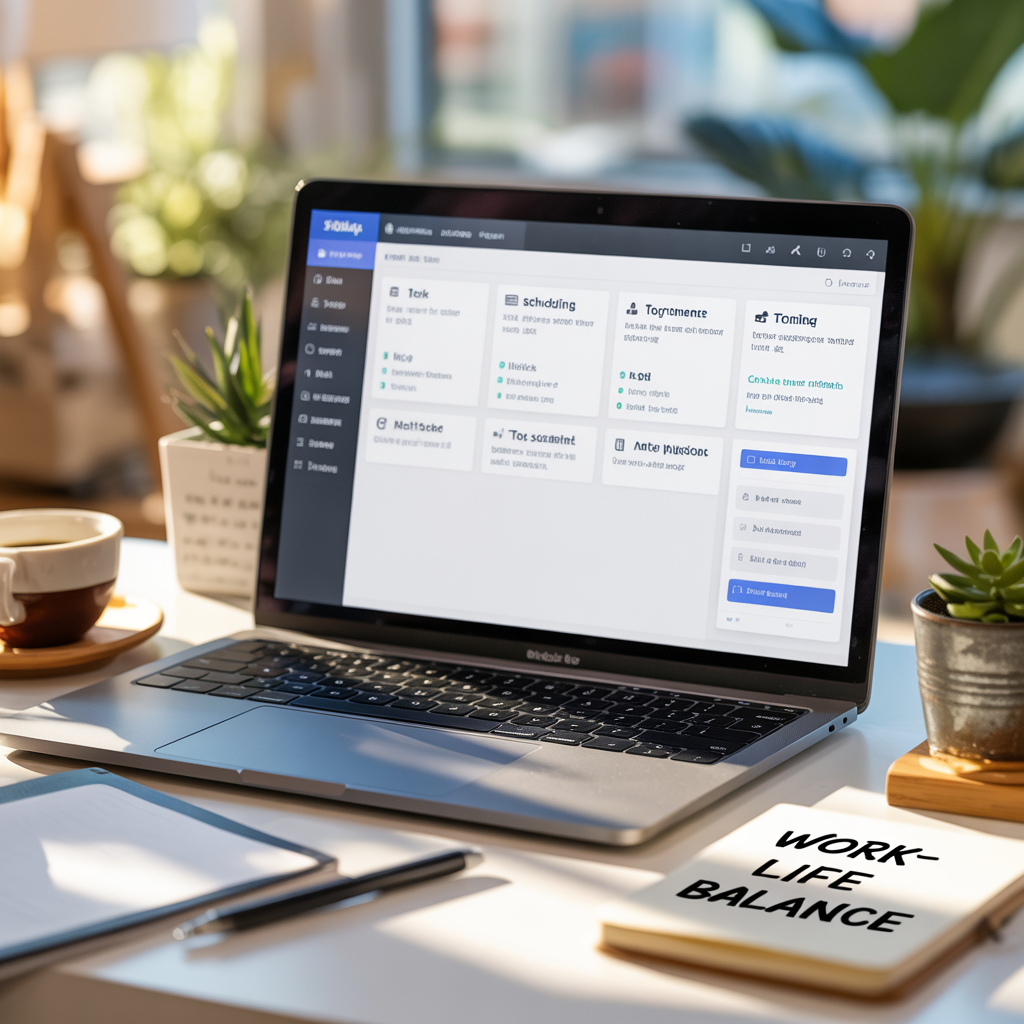
Ever felt like you’re a hamster on a wheel, running between deadlines and family dinners without catching your breath? You’re not alone. A shocking 77% of professionals report feeling burnout from the constant tug-of-war between work and personal life.
I’m not here to sell you on perfect balance—that’s a myth. What I will give you is a practical roadmap to work-life harmony that actually fits your real life, not some Instagram fantasy.
Finding your personal sweet spot between career ambition and life satisfaction isn’t about rigid schedules or productivity hacks. It’s about intentional choices that align with your priorities.
But here’s the question that changes everything: What if the solution isn’t about managing time better, but about managing energy instead?
Defining Work-Life Balance
What is Work-Life Balance Exactly?
Work-life balance isn’t just a fancy buzzword. It’s about having enough time for your job and still being able to enjoy your personal life without feeling like you’re drowning.
Think about it. When was the last time you felt completely present during family dinner instead of mentally reviewing tomorrow’s presentation? Or when did you last take a weekend off without checking emails?
That’s what we’re talking about here.
True balance doesn’t mean splitting your hours perfectly down the middle. Some days work needs more attention, other days life does. The key is having control over when those shifts happen, rather than feeling constantly pulled in all directions.
The Impact of Work-Life Balance on Mental Health
Poor work-life balance messes with your head. That’s not dramatic—it’s science.
When you’re always “on,” your stress hormones never get a chance to reset. Your brain stays in fight-or-flight mode. The results? Anxiety, depression, burnout, and even physical problems like high blood pressure and a weakened immune system.
On the flip side, good balance gives your brain recovery time. It’s like hitting the reset button. You sleep better. Think clearer. Feel happier.
The numbers don’t lie:
- 76% of workers with good balance report better mental health
- Burnout risk drops by 68% when people feel their work and life are in harmony
- Recovery time between work sessions boosts productivity by up to 40%
Achieving Work-Life Balance: A Personal Journey
Nobody’s work-life balance looks exactly the same. Your version depends on your priorities, family situation, career, and what makes you feel fulfilled.
Start by auditing where your time actually goes. Most people are shocked when they track their hours. That “quick email check” on Sunday? It’s stealing more time than you think.
Small shifts make big differences:
- Create hard boundaries (like no phone during dinner)
- Schedule personal activities with the same commitment as work meetings
- Learn to say no (seriously, practice it out loud)
- Find your productivity sweet spots and protect them fiercely
The journey to balance isn’t linear. You’ll have weeks where everything flows perfectly, followed by complete chaos. That’s normal.
What matters is noticing when you’re off-track and having tools to correct course instead of spiraling.
Achieving Work-Life Balance Tips

A. Lotus Template from Strikingly
Ever tried juggling work deadlines while remembering your kid’s soccer game? Yeah, it’s tough. That’s where Strikingly’s Lotus Template comes in clutch.
This template isn’t just pretty—it’s a game-changer for anyone drowning in the work-life quicksand. The clean layout helps you visualize your commitments side by side. Work tasks on one panel, personal goals on another.
What makes Lotus special is how it color-codes your priorities. Red for urgent work stuff, blue for family time, green for self-care. Simple but brilliant, right?
I started using it last month, and honestly? My stress levels dropped like a rock. The template forces you to assign time blocks for both work AND life—not just work disguised as life.
The best part? You can access it from any device. Update your schedule during lunch, check family commitments during your commute.
B. Setting Boundaries and Prioritizing Self-Care
You can’t pour from an empty cup. Sounds cliché, but it’s dead-on accurate.
Boundaries aren’t selfish—they’re survival tools. Start small:
- No work emails after 7 PM
- Lunch breaks actually used for eating, not meetings
- One full weekend day technology-free
Self-care isn’t just bubble baths and face masks (though those are nice). It’s saying “no” to that extra project when you’re already maxed out. It’s sleeping enough. It’s remembering you’re a human, not a productivity machine.
Try this: Every morning, write down THREE non-negotiable self-care activities for the day. Could be a 10-minute walk, reading before bed, or calling a friend. Then protect those activities like they’re million-dollar meetings—because your wellbeing is worth more.
C. Time Management Strategies for a Balanced Life
Time isn’t just money—it’s life itself. So why do we waste it on stuff that doesn’t matter?
The Eisenhower Matrix changed my approach completely. Draw a square, divide it into four boxes:
- Urgent & Important: Do immediately
- Important but Not Urgent: Schedule it
- Urgent but Not Important: Delegate
- Neither Urgent nor Important: Eliminate
Another trick? Time blocking. Instead of a to-do list, create a time map. Assign specific hours to specific tasks—including relaxation and family time.
Batch similar tasks together. Answer all emails in one go. Make all phone calls back-to-back. Your brain wastes energy switching contexts.
The 2-minute rule is gold too. If something takes less than 2 minutes, do it now. Don’t add it to your list.
D. The Role of Communication in Work-Life Balance
Nobody’s a mind reader. Your boss doesn’t know you’re drowning unless you speak up.
Clear communication prevents the “always available” trap. Tell your team when you’re offline—and stick to it. Set your status. Use auto-replies. Make your boundaries crystal clear.
With family, communication looks different. It’s about quality, not quantity. A focused 30-minute conversation trumps two hours of distracted half-listening while checking emails.
Try a weekly family meeting. Sounds formal, but it works wonders. Everyone shares their schedule, needs, and expectations for the week ahead.
For couples, try the “temperature check”—a quick daily check-in using numbers: “I’m at a 4 today” might mean you need extra support. Simple but effective.
Remember: work-life balance isn’t about perfect 50/50 division. It’s about feeling fulfilled in both worlds without sacrificing your sanity.
The Work-Life Balance Benefits
A. Massage Therapist Template from Strikingly
Ever noticed how a good massage melts away stress? That’s exactly what a proper work-life balance does for your career. Strikingly’s Massage Therapist Template isn’t just for spa professionals—it’s a perfect metaphor for how balance should feel.
When your professional and personal lives are in harmony, everything just flows better. No knots, no tension points. Just smooth sailing.
The template itself emphasizes clean design with breathing room—exactly what your schedule needs. White space matters, both on websites and in calendars. Give yourself permission to have unfilled hours. Those gaps aren’t wasted time; they’re recovery periods.
B. Increased Productivity and Job Satisfaction
Want to know the dirty little secret about working 60-hour weeks? The last 20 hours are pretty much useless.
Your brain simply doesn’t function well when overtired. Studies show that after 50 hours of work, productivity drops so dramatically that you might as well be scrolling through cat videos.
When you balance work with rest:
- You solve problems faster
- Creative solutions come naturally
- Decision-making improves dramatically
- Your satisfaction skyrockets
People with balanced lives report 87% higher job satisfaction. Why? Because they’re not resentful of work consuming their existence.
C. Better Physical and Mental Well-being
The human body wasn’t designed for constant stress. Period.
Work-life imbalance shows up physically as:
- Disrupted sleep patterns
- Weakened immune system
- Persistent headaches
- Weight fluctuations
- Heart problems
Mentally, the toll is even worse. Burnout isn’t just feeling tired—it’s a complete system shutdown. Your brain actually changes when chronically stressed, making it harder to feel joy or satisfaction from accomplishments.
The flip side? People with good balance live longer, healthier lives with lower rates of depression and anxiety.
D. Work-Life Balance: A Key to Long-term Career Success
The marathon runners have it right. Pace yourself.
Sprint-working might get you quick promotions, but it’s the balanced professionals who sustain decades-long careers. They understand something critical: sustainability beats speed.
Career longevity requires:
- Emotional resilience
- Network building (which happens during “life” hours)
- Continuous learning (which needs mental space)
- Perspective (gained outside office walls)
The most successful people aren’t working every waking moment. They’re experiencing life, building relationships, and bringing those insights back to work. That’s how innovation happens—not from staring at a screen until midnight.
Real-life Examples of Work-Life Balance
Exploring Successful Balancers: Oprah Winfrey and Richard Branson
Ever wonder how the mega-successful manage it all? Oprah Winfrey didn’t become a media mogul by burning herself out. She swears by her “mental health days” and morning meditation ritual. Five minutes of gratitude journaling starts her day, followed by exercise. She doesn’t apologize for prioritizing self-care—it’s what fuels her empire.
Richard Branson, despite running 400+ companies, still finds time to kitesurf and hang with family. His secret? He wakes at 5 AM for exercise, which he claims gives him four extra productive hours daily. Plus, he works from Necker Island half the time. Not too shabby.
Lessons from Leaders: How Elon Musk and Sheryl Sandberg Prioritize Work-Life Balance
Elon Musk’s approach is… complicated. The Tesla/SpaceX CEO famously worked 120-hour weeks and slept on the factory floor during production crunches. But he’s evolved. Now he blocks time into 5-minute slots and dedicates entire days to his five sons. His advice? “Focus on signal over noise.”
Sheryl Sandberg takes a different route. The Facebook exec leaves work at 5:30 PM to have dinner with her kids—no exceptions. After they’re asleep, she jumps back online. She also keeps a strict “off the grid” policy on vacations. Her philosophy? “Done is better than perfect.”
Navigating Work-Life Balance in Various Professions
The balance looks different depending on your job:
Healthcare workers often use “compressed schedules”—three 12-hour shifts instead of five 8-hour days—giving them 4-day weekends.
Teachers adopt “batch processing,” grading papers in focused blocks rather than spreading the work across evenings.
Remote tech workers create “transition rituals”—changing clothes or taking a walk after logging off—to separate work from home life.
Entrepreneurs practice “time blocking” and “deep work” sessions, often working in 90-minute sprints with breaks in between.
The common thread? They all set boundaries and stick to them like their sanity depends on it—because it does.
Strikingly Features for Achieving Work-Life Balance

Increased Efficiency through Streamlined Online Presence
Ever tried juggling fifty browser tabs while searching for that one client email? Yeah, not fun. Strikingly changes that game completely.
With Strikingly’s all-in-one platform, you can manage your entire online presence from a single dashboard. No more switching between hosting services, design tools, and content managers. Everything lives in one place.
The drag-and-drop editor saves hours of design work. What used to take days now takes minutes. Build stunning websites without touching a line of code—seriously, zero technical skills required.
The template library is a goldmine for busy professionals. Pick a design, customize it, and boom—you’re online. When you’re not wasting precious hours on website maintenance, those hours go back into your personal life.
Automation tools handle the repetitive stuff. Set up automatic backups, schedule posts, and let the platform update itself. While Strikingly handles the busywork, you can focus on what matters—or better yet, clock out and enjoy your evening.
Improved Communication and Collaboration
The endless email chains? They’re history with Strikingly’s built-in collaboration tools.
Teams can work simultaneously on projects, seeing changes in real-time. No more “Sorry, I didn’t see your email” excuses or version control nightmares. Everyone stays on the same page, literally.
The comment feature lets teammates leave feedback directly on specific elements. No more vague instructions like “fix the thing on the homepage.” Just point, comment, and it’s clear.
Take the First Step towards Work-Life Balance
Embracing a Balanced Lifestyle
Ever noticed how some people seem to have it all together? They’re crushing it at work while still making time for family dinners and yoga classes.
The secret isn’t superhuman abilities—it’s intentional choices. Making that first move toward balance starts with a simple truth: you can’t do everything.
Pick three priorities for this week. Just three. Maybe it’s finishing that big project, attending your kid’s soccer game, and getting in two workouts. Write them down somewhere you’ll see them daily.
Next, look at your calendar. Does it reflect these priorities? If not, something’s gotta give. Maybe that’s saying no to the committee you don’t really care about, or setting an alarm to stop working at 6pm sharp.
Balance isn’t about perfect equality—it’s about alignment. Some weeks will lean heavier on work, others on personal life. That’s normal. What matters is that you’re making conscious choices rather than running on autopilot.
The Road to Achieving Work-Life Harmony
The journey to work-life harmony isn’t a straight line—it’s more like a winding path with occasional detours.
Start small. Taking a proper lunch break away from your desk can be revolutionary. So can turning off email notifications after hours.
Try the “bookend” technique: create morning and evening rituals that separate work from personal time. Maybe it’s a morning walk or an evening journaling session.
The people who succeed at this don’t wait for permission. They don’t say “I’ll create boundaries when my boss does” or “I’ll take vacation when things slow down.”
They decide what matters and protect it fiercely.
Remember that phone call from a friend you’ve been putting off? Make it tonight. The meditation app collecting digital dust? Open it tomorrow morning.
Small steps create momentum. One boundary leads to another. One success builds confidence for the next challenge.
You don’t need to overhaul your entire life tomorrow. Just take that first step.
Finding the sweet spot between professional responsibilities and personal well-being is an ongoing journey that requires intention and courage. By understanding the causes of work-life imbalance, setting clear boundaries, and utilizing tools like Strikingly’s features, you can create a sustainable approach to balancing your career ambitions with your personal needs. The benefits—improved mental health, increased productivity, and stronger relationships—make this journey well worth the effort.
Your next brave step toward work-life harmony doesn’t need to be monumental. Start small by implementing one tip from this guide, whether it’s scheduling dedicated family time, learning to say no, or creating a more efficient workspace. Remember that balance looks different for everyone, and the real success comes not from perfection, but from making consistent choices that honor both your professional goals and personal happiness.














No Comments